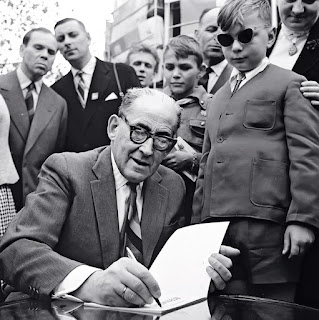Analysis of Poems for Children by Jan Brzechwa
I am going to analyze 5 poems by a Polish writer, Jan Brzechwa that are included in the collection of poems Brzechwa for children (Brzechwa dzieciom). I chose the poems by this author because I was read his poem when I was between 4-6 years old and later on I read his poems for myself, learning many of them by heart when I has been in elementary school. I loved Jan Brzechwa as a child. I like his rhymes, short form and witt. Also the stories that he describes in each and every poem were very interesting for me, and still I feel that he had a talent to write about something in few lines.
The poems “Samochwała” (A Boaster), “Kłamczucha” (A Liar), “Pytalski” (the boy’s surname means a person who asks )and “Leń” (A Lazy Boy) describe flaws that children possess (but also adults). Samochwała is talking standing alone in the corner. “Kłamczucha” is written in the form of dialogue. In “Pytalski” – speaking I describes the boy using the questions that he might use. In “Leń”, the boy is as if he answers to the speaking I narration. What is similar in all of the poems is the fact that they seem as a part of a narrative, even though they are rhymed. All of them have obvious titles which state the topic of poems and name characters.
“Samochwala” is divided into two parts. It starts with two lines in which a 3rd person speaking
I describes where and who she is. Second stanza is a 18-lines long monologue of the girl. The
poem has tail rhymes arranged in a rhyme scheme “AABB” (nieslychanie/ubranie). Samochwala describes her values beginning with her looks. She talks about her clothes, face which has very healthy complexion. Then she describes her abilities (riding a bike, singing) graduating them from very simple to ridiculous (catching flies in line 11). In the end of this description she uses only adjectives. This literary technique gives the poem fast rhythm and is used to show that Samochwala urges in the flow of words. Last five lines are the climax of the poem. The speaker talks about her family exaggerating about their features (mum is extremely fat, dad enourmously tall and the sister unusually small). In this point the child to whom the poem may be read knows for sure that Samochwala speech is ridiculous and untrue. The final sentence in which the speaker introduces herself as boaster reminds the addressee that talking about ourselves is a flow. Child, after reading such a poem can see that it is farcical and silly to boast about themselves. This way, Brzechwa teaches how not to behave, without being moralistic. It is very good because normally children will not listen to commands and prohibitions. Being at the age of 6-10, they are intelligent enough to draw conclusions from the poem.
In my opinion, Brzechwa wisely “smuggles” lessons that he gives to children without clear preaching. What is more, his rhymed poems are funny and short so they do not weary and bore children.The very same pattern is visible in the rest of the poems that I describe. “Klamczucha” (A Liar) has 30 lines and only one stanza. Each line has eight syllabs. What is more, it has a refrain that is repeated 3 times: “Proszę pana, proszę pana (Sir,sir!)”. The refrain follows utterances of the second speaker of the dialogue – a man who criticizes girl’s lies.
In my opinion, Brzechwa wisely “smuggles” lessons that he gives to children without clear preaching. What is more, his rhymed poems are funny and short so they do not weary and bore children.The very same pattern is visible in the rest of the poems that I describe. “Klamczucha” (A Liar) has 30 lines and only one stanza. Each line has eight syllabs. What is more, it has a refrain that is repeated 3 times: “Proszę pana, proszę pana (Sir,sir!)”. The refrain follows utterances of the second speaker of the dialogue – a man who criticizes girl’s lies.
The title Liar is the first speaker of the poem. The whole poem is in the convention of a dialogue, however the girl speaks a lot while the man speaks only in 6 lines altogether. In this poem the graduating of the arguments that the child uses is not present. The very first lie that the girl mentions is turning her sister Bronka into a bird. Again Brzechwa uses rhyme scheme “AABB” and mainly identical rhymes. The rhythm of this poem is fast and balanced from the beginning till the end. For a child who listens or reads this poem, it is clear from the third verse that the Liar is lying. An addressee knows that there is no such a thing as lemonade rain nor is ABC-book able to eat a piece of meat. The man who speaks in the poem interrupts the stream of words that belongs to the Liar. His function is significant also because he questions the girl’s stories and she lies anyway, denying his criticism. In the end when the Liar describes how a duck drown in a pond and firefighters filtered water from it, the Sir has enough. He says that it is wrong to lie and threatens the girl that he will tell the Liar’s mother on her, which concludes the poem. Again the moral that children should never lie is hidden and not clearly stated.
An addressee learns that lying is wrong and simply is not in favour for themselves because they will be punished. This image from the text is clear enough for children. When I was a child I did not think about moralistic idea of the poem but I thought that I should not lie or I will be punished by my parents because somebody will tell them. Brzechwa uses very simple language again.
He does not include any difficult words. A plain language allows every child to understand and enjoy the poem.
A Lazy Boy (Leń) is the longest poem of all that I concern. It has six stanzas, including 2-line refrain repeated three times. The refrain is a comment given by the speaking I in 3rd person. It explains that there is a lazy boy on the couch who does nothing for the whole day. The speaker of the rest of the six stanzas is the lazy boy Len. In stanzas 2 and 4 he uses rhetorical questions to points out the things that he has done earlier. His acts are ridiculous because he
4
thinks that it counts that he has been lying, sitting or scratching his head. The monotony of the lazy boy’s dialogue is interrupted by the voice of the speaking I, which seems to be calm and not cheated by Leń’s monologue. The last stanza of the poem is a long comment of the speaking I that explains what really the lazy boy has been doing earlier. The reader learns that the boy does nothing apart of sleeping and daydreaming. Again, Brzechwa shows certain mode of behavior, rather than preaches how to behave. The author mocks the boy’s excuses showing that it is only what he says and not what actually happens. The addressee can simply think about his or her own behavior and compare it to Len.
The whole poem is rhymed in the mood that we know from other poems “AABB”. Apart of rhetorical question it does not contain any stylistic devices. It is however full of irony that cannot necessarily be understood by a child. Therefore, the poem can be read by an adult and the grown-up addressee can, for sure, enjoy it.
The second poem that involves a boy as a main person is Stas Pytalski. The poem is divided into three stanzas beginning and ending with shorter stanzas than the middle one which lists Stas Pytalski’s questions. The scheme of rhyme is traditionally “AABB” but the rhymes are not identical. The first stanza describes who the title character of the poem is and where does he live (at St Trybunalska). The rhetorical questions in stanza 2 refer to the fact that children often ask about everything that is around them. As far as it is important to answer to the curious child, sometimes it can be tirenig. Brzechwa shows an example of untiring boy who keeps asking questions about the most elaborate things (e.g how many flies can swim in a soup, where do brunets come from etc).
Third stanza shows reaction of Pytalski’s family toward his questions. Gradually the addressee learns that his grandpa has been thinking a year about the answers, grandma turns grey, mum got neurosis and dad went out and nobody knows where will he come back. The last two lines about the father are interesting also from the point of view that Brzechwa uses phraseme “iść po rozum do głowy” which in direct translation means go for the brain to ones head, but means simply “to think”. Brzechwa plays with this phrase and uses its both meanings.
When I was told the poem I remember, that I could not catch the metaphorical meaning and any time I have heard or read the poem, I thought that the father actually went out of the house. I think that Brzechwa is aware of the fact that children will not understand the phraseme, but thanks to his direct usage of it – children understand the poem their own way.
Brzechwa uses imagism to present the characters. In all of his poems he uses the same rhyme scheme “AABB” which is the simplest to read and enjoy for the kids. It allows to turn his poem into songs, a child may even give it his or her own melody. Poems are short, most of them has about thirty 8 -syllabic lines. All of them describe children with flows, both boys and girls. Thanks to vivid description which mocks certain actions (mostly speaking too much, exaggerating and lying) Brzechwa avoids moralizing and preaching. His poems show why children should not boast about themselves, lie, ask too much and be lazy. Brzechwa as an author takes into account the fact that children are clever and they can understand what is appropriate behavior when they see an example. The poems are funny and simple but the truth that is in them is very deep and universal. Their form is adjusted to children’s knowledge of language and their fantasy. The poems are vivid and allow to picture the speakers.


Komentarze
Prześlij komentarz